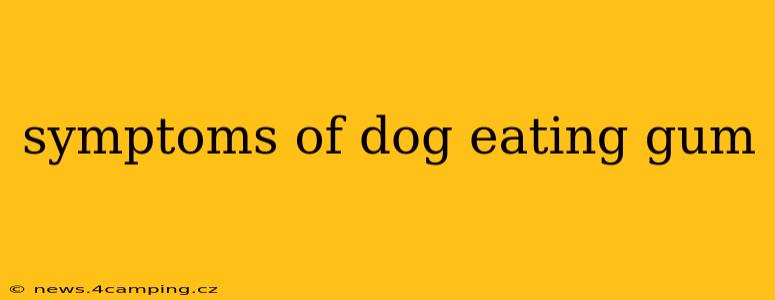Accidental ingestion of chewing gum by dogs is more common than you might think. While some gums might cause only minor digestive upset, others contain ingredients that can be seriously toxic to your canine companion. Understanding the symptoms of gum ingestion and knowing how to react quickly is crucial for your dog's well-being. This guide will equip you with the knowledge to identify potential problems and take appropriate action.
What are the Symptoms of a Dog Eating Gum?
The symptoms a dog displays after eating gum depend heavily on the type of gum consumed and the quantity ingested. Some gums might cause only mild gastrointestinal distress, while others containing xylitol, a common artificial sweetener, can lead to a life-threatening emergency.
Mild Symptoms (often from non-xylitol gums):
- Upset stomach: This is the most common symptom and might manifest as vomiting, diarrhea, or loss of appetite. Your dog might also seem lethargic or listless.
- Gastrointestinal discomfort: You might notice your dog exhibiting signs of abdominal pain, such as restlessness, whining, or a hunched posture.
- Constipation: Depending on the gum's ingredients, it could cause constipation due to its sticky nature.
Severe Symptoms (often from xylitol-containing gums):
- Sudden hypoglycemia (low blood sugar): This is a very serious and potentially fatal consequence of xylitol ingestion. Symptoms can include weakness, collapse, tremors, seizures, and loss of coordination.
- Liver failure (delayed onset): Xylitol can cause severe liver damage, which might not manifest immediately but can lead to fatal consequences days or weeks after ingestion.
- Coagulation problems: Xylitol can disrupt blood clotting, potentially leading to bleeding disorders.
What should I do if my dog ate gum?
Immediate Action:
- Identify the gum: Try to determine the brand and ingredients of the gum your dog ate. This is especially crucial if you suspect it contains xylitol. Check the packaging if possible.
- Contact your veterinarian or an animal poison control center immediately. Do not wait to see if symptoms develop, especially if you suspect xylitol ingestion. Time is of the essence in these cases. They can provide guidance based on the specific gum and your dog's condition.
- Do not induce vomiting unless instructed by a veterinarian or poison control center. Inducing vomiting incorrectly can be more harmful than helpful.
- Monitor your dog closely: Observe your dog for any changes in behavior or symptoms, noting the time of ingestion and the onset of any symptoms.
How much gum is too much for a dog?
There's no magic number. Even a small amount of xylitol-containing gum can be dangerous, depending on your dog's size. The toxicity of non-xylitol gums depends on the ingredients and the amount consumed. A large quantity of any gum can cause gastrointestinal upset. The best approach is to prevent your dog from accessing any gum whatsoever.
What ingredients in gum are toxic to dogs?
Xylitol: This artificial sweetener is the most dangerous ingredient in gum for dogs. Even tiny amounts can cause a rapid drop in blood sugar and potentially lead to liver failure.
Other potentially harmful ingredients: Some gums contain other artificial sweeteners, flavorings, or preservatives that could cause gastrointestinal upset or other reactions in dogs.
My dog ate sugar-free gum; should I be worried?
Sugar-free gum often contains xylitol, which is highly toxic to dogs. If your dog ate sugar-free gum, immediate veterinary attention is crucial.
Can dogs eat regular gum?
No, dogs should not eat regular gum. While not as dangerous as xylitol-containing gum, regular gum can still cause gastrointestinal upset and potentially lead to blockages due to its stickiness.
How do I prevent my dog from eating gum?
- Keep gum out of reach: Store gum in high cabinets or containers inaccessible to your dog.
- Supervise your dog: Always supervise your dog, particularly when you are eating gum or have it out.
- Train your dog: Teach your dog commands like "leave it" or "drop it" to prevent them from picking up dropped items.
By understanding the potential dangers and symptoms associated with gum ingestion, you can take swift action to protect your canine companion. Remember, prevention is key, but prompt veterinary care is essential if your dog does consume gum, particularly if it contains xylitol.
